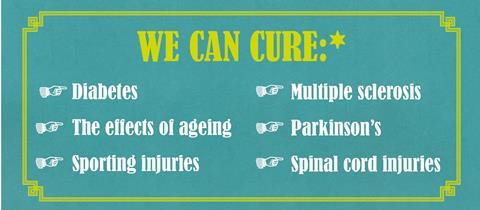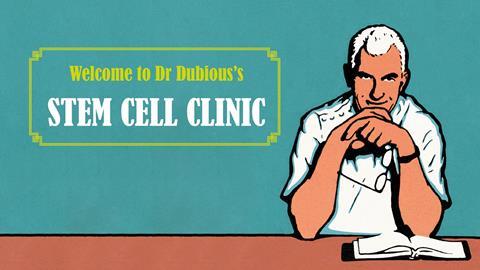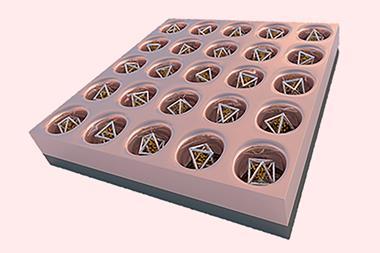Many clinics around the world offer unproven treatments, while genuine therapies are slowly making their way through trials. Anthony King reports
Search for stem cell clinics online and you will easily find them, all over the world, offering to treat a raft of health problems. Many target sports injuries, osteoarthritis and anti-ageing, but some advertise cures for heart disease, Parkinson’s disease and spinal cord injury. The problem: these are unproven therapies.
‘It’s an incredibly promising field and we are going to see clinical benefits,’ says public health expert Tim Caulfield at the University of Alberta in Canada. ‘But there aren’t really many therapies that are ready for the clinic.’ Caulfield has a long-time interest in stem cell clinics and says the situation is not getting any better. Their proliferation is happening in well-regulated, wealthy countries. Sometimes, these treatments endanger patients.
The therapies can cost anywhere from a few thousand dollars up to $20,000 (£16,000). What tends to happen is that a small sample of adipose tissue is taken from the patient and reinjected elsewhere. ‘A lot of them take cells from the butt and inject them say into the spine, though they will use clinical jargon,’ says Kirstin Matthews, a biomedical policy researcher at Rice University in Houston, Texas. Stem cells can also be extracted from bone marrow, an accepted procedure for certain conditions such as leukaemia.
The companies play cat and mouse with the regulators
Proper clinical trials usually grow stem cells up in a lab, treat them so they differentiate into a particular cell type and quality-check them before reinfusing them into a patient. Meanwhile, unregulated clinics employ all sorts of non-standardised protocols to give patients back stem cells. Clinics have sprung up in Canada, Australia, Japan and throughout Europe, and the US is one of the most prolific markets. Stem cell researchers tend to believe the situation is improving, but long-time clinic watchers think otherwise.
‘It’s really a growing problem in the US,’ says Matthews, despite the Food & Drug Administration (FDA) issuing public warnings and taking more action against clinics. Caulfield sees the situation getting worse in Canada too. At the heart of the problem is defining what is a medical procedure and what is a therapy. ‘Drug regulators like the FDA or European Medical Agency do not regulate the practice of medicine, they regulate the marketing of drugs,’ explains Jonathan Kimmelman, biomedical ethicist at McGill University in Montreal, Canada. Removing patient cells and reinjecting them is akin to a blood transplant and has not been covered by drug regulators. So long as the clinics do ‘minimal processing’ of the cells, in the US they are in the clear. ‘The companies play cat and mouse with the regulators to make sure they fall into compliance,’ says Kimmelman.
One study identified 351 US-based businesses marketing non-FDA approved stem cell interventions to consumers at 570 clinics. Subsequently, the same researchers found 90 to 100 new stem cell business websites appeared each year from 2014 to 2016. A 2017 study of 200 search engine results found that most, 44%, were from treatment clinics, with media articles second.1
Some of the most common disorders advertised by clinics are anti-ageing and skin care; diabetes; sports and orthopaedic conditions; multiple sclerosis (MS); Parkinson’s and spinal cord injury. Most of these conditions are years away from recognised treatment. ‘Many of these clinics don’t even advertise this as an experimental treatment,’ says Caulfield, who is frustrated at how stem cells are misrepresented as effective online and in newspapers and magazines.
Right to be fooled

Caulfield, having studied this issue for a decade, says there is a shift happening, but in the wrong direction. ‘So much pop culture has embraced stem cells that its efficacy is taken as a truism,’ he says. ‘It is becoming increasingly difficult to fight the noise.’ Patients can now purchase ‘stem cell creams’ on the internet, – a laughable claim, but Caulfield is serious. It exploits genuine public excitement about stem cells to market a product that is ridiculous, but this is still important. ‘It helps embed in the public mind that stem cells work and are routine,’ says Caulfied. Similarly, news report about sports stars recovering after stem cell treatments succeed in evangelising what are unproven medical procedures. ‘If you are getting cell-based interventions for a disease, it should for the most part be in the context of a clinical trial,’ warns Kimmelman.
In the US, stem cell clinics are carried along in the push for greater access to unproven treatments, enshrined in many state and now federal law as ‘right to try’ legislation. The public dialogue around access to therapies fuelled arguments around an insidious government bureaucracy attempt to stop desperate patients from accessing cures.
These clinics are adept at manipulating desperate patients
In the US crowdfunding is popular for stem cell treatments for neurological diseases, with MS the most common condition. A recent study identified 1030 crowdfunding campaigns for neurologic diseases and injuries, receiving over $5 million from 38,713 donors.2 Mark Freedman, a neurologist at the University of Ottawa in Canada, has problems with any clinic offering treatment other than bone marrow transplant for MS. A trial with adult stem cells for MS is due out this year, but ‘we are still years away from credible treatments for patients’, he adds.
‘What ties together many of these disorders is that we don’t have effective treatments and they are very disabling disorders,’ says Kimmelman, giving Parkinson’s and spinal cord injury as examples. Symptoms for Parkinson’s can be managed for a period of time but the course of the illness is relentless. Patients are understandably eager to exhaust all options. ‘These clinics are adept at manipulating desperate patients,’ observes Kimmelman. ‘There is also a prestige around stem-cell based interventions. There may be a perception that patients are accessing tomorrow’s cutting edge treatments.’
On trial
Cutting edge treatments do exist, but only as small trials. Pete Coffey at University College London reported in 2018 that two elderly patients had been treated with an implanted patch of retinal cells derived from embryonic stem cells.3 The patients, who had age-related macular degeneration (AMD), went from not being capable of reading, to 60–80 words per minute with normal reading glasses.
At Cardiff University in the UK, neuroscientist Anne Rosser isolated the brain cells lost in Huntington’s disease patients using foetal brain tissue in a proof-of-principle work. Eventually, the aim is to instead insert the correct brain cells, derived from off-the-shelf stem cells, into the brains of patients with Huntington’s and similar diseases. ‘We aren’t at the stage where we can be confident enough to put stem-cell derived cells into patients,’ says Rosser.
In parallel, as part of a European project, her research is preparing for this day, having spent five years generating clinical grade stem cells from embryonic cells that could go into future patients. ‘We are starting to see first-in-man studies in Parkinson’s but we are a long way off using this routinely. These are unproven therapies,’ Rosser emphasises. She says there is no evidence that treatments in for-profit clinics are justified for neurodegenerative disorders. When contacted by patients, she tries to dissuade them from attending such clinics.
In one case, a stroke patient received a stem cell injection and ended up with a tumour
Still, when patients read about progress in trials or research papers, it can be hard to distinguish cutting edge research from unregulated clinics. ‘It is confusing for patients to know there are high quality clinics and then problematic ones,’ says Kimmelman. ‘Cell-based interventions have a good reputation because they are backed by state-of-the-art scientific research and these clinics are free-riding off that prestige.’ The confusion is no accident. Caulfield refers to the leveraging of the language and real excitement about the potential of stem cells in order to market unproven products as ‘scienceploitation’.
Patients may lose financially, miss out on legitimate treatments or even suffer nasty side effects. In Florida, three elderly women went blind after receiving injections of their own cells into their eyes. The treatment was legal, but of unproven benefit and safety. In another case, a stroke patient received a cell injection and ended up with a tumour. ‘Stem cells can go to the wrong part of the body, develop into abnormal growths or tumours, or can be contaminated and lead to an infection,’ warns Kimmelman. ‘Some people have been given sheep and rabbit stem cells, and sometimes blood stem cells [from other people] that haven’t been matched, which will be rejected by the body,’ says molecular biologist Michael Pepper at the University of Pretoria, who says a handful of clinics operate in South Africa, working on the fringes of the law.
Hope or hype?

The seeds of unscrupulous stem cell clinics were, according to many, sown in the late 1990s, when the promise of stem cells began to excite researchers. Initial focus centred on embryonic stem cells. The debate was polarised from the start. ‘Those who wanted it banned said it was evil,’ says Caulfield, because it involved the destruction of embryos. Stem cells from this source are pluripotent, meaning they can become almost any cell. ‘The scientists who wanted to go forward were using equally hyperbolic language, saying this is going to lead to miracle cures and revolutionise medicine,’ Caulfield adds.
In 2001, there were limits placed on stem cell research in the US by the Federal government. It was up to scientists to lobby politicians and make the case for more unfettered research into embryonic stem cells, which pumped up expectations. Many scientists agree that this became a problem. ‘There was a tremendous amount of hype, with misplaced, over-stated and exaggerated promises. Lots of people contributed, not least scientists and clinicians working in the field,’ says Frank Barry, scientific director of the Regenerative Medicines Institute in NUI Galway in Ireland.
This flooded into popular culture. Caulfield found that around 70% of reports in major daily newspapers in Canada, the US and UK between 2010 and 2013 suggested that research, often quite basic research, would be in the clinic in five to 10 years.4 ‘That kind of “timeline hype”, coming from the mouths of researchers, can create a lot of public expectation that this will be ready for the clinic sooner than it possibly could,’ says Caulfield.
It took an inordinate amount of time to complete the randomized controlled trials
Now, with unproven stem cell therapy on offer, the research community has reason to worry. ‘There’s a risk that this could drag down cutting edge research,’ warns Kimmelman. It may prove harder to recruit patients for randomised control trials, where patients may or may not receive placebo or therapy. Patients may find what looks like a similar treatment available in a clinic and opt for that.
A salutary tale occurred in the 1990s when breast cancer patients received high dose chemotherapy and bone marrow transplantation, a strategy used successfully in other types of cancer. Small studies indicated it could help breast cancer patients. Patients successfully demanded and received what was an unproven treatment. As a result, ‘it took an inordinate amount of time to complete the randomized controlled trials that evaluated the safety and efficacy of the intervention. Patients wanted to receive treatment, not risk being in the control group of a trial,’ noted an account published in 2015.5 Eventually, results showed that the combined approach did not improve survival, could reduce lifespan and increased discomfort compared to the standard approach. ‘This is a cautionary tale in introducing unproven clinical therapies too early,’ argues Kimmelmen, who was a co-author of the study.
The International Society for Stem Cell Research lists on its website questions that patients should ask when considering any stem cell treatment. ‘They are worried about patients getting frustrated when [stem cell therapies] turn out not to work and then not believing in legitimate therapies when they start to emerge,’ says Caulfield. Some stem cell clinics do track results, but their protocols are not standardised and so are unlikely to be comparable to other clinics. A bunch of bad observational studies may come out that just muddy the literature. Also, some trials listed on ClinicalTrials.gov rely on patients paying to participate, which need to be screened out according to Leigh Turner, a bioethicist at the University of Minnesota in the US. There’s also a problem with trials not reporting results.
The involvement of medical professionals may reassure patients about the legitimacy of these procedures. Kimmelman says these clinicians are either unable to make a balanced assessment of the science, or out to exploit patients. He encounters stem cell clinics purporting to treat Parkinson’s disease run by physicians, rather than specialist neurologists. ‘I find that strange, but there are corrupt people in every profession and patients should not take much comfort that these people are often physicians,’ says Kimmelman
The real deal
March 2018 saw the first market approval of a stem cell therapy in Europe, based on a Phase III trial carried out by TiGenix in patients with Crohn’s disease. Barry is leading a Phase IIb clinical trial at 10 clinical sites around Europe for the treatment of osteoarthritis. A small sample of cells is taken from a patient’s fat tissue and stem cells are grown up, before injecting them into patients. A cursory search online turns up a clinic in Ireland, the UK and Switzerland offering what looks like the same procedure.
Not so. Barry’s group enriches the stem cell from patients by growing them in special media for two weeks. ‘We give them specific nutrients, select for stem cells and wash away other cells,’ Barry explains. They examine the cell morphology, monitor how well they grow or die, and search for the right (and wrong) proteins on their surface, as well as check for contaminants. ‘There’s always a possibility that the cells could do the wrong thing, maybe give rise to a tumour, or go to the wrong place,’ says Barry, though neither has happened. He expects the study to finish in 2020.
It is important to distinguish between what is legal and what is ethical
The tissue stem cells in this procedure may work partly by having an anti-inflammatory impact, modulating the patient’s immune response. There is great interest too in using induced pluripotent stem cells, which are similar to embryonic stem cells in their ability to turn into almost any cell. They are made by treating ordinary skin cells in a way that turns back time, a rejuvenation process, but for now the newly minted stem cells hold a residual memory of what they once were. It is generally accepted that more research is needed before patients could receive this type of stem cells. Again, there is a great deal of hope that they could be used for all sorts of difficult to treat conditions.
Researchers are arguably now more cautious in trumpeting advances. ‘The entire field has delivered at a slower pace that I would have thought 10–15 years ago,’ Barry admits. Some applications have proved harder than others. It’s widely acknowledged that the potential for stem cells having a fast impact in cardiology was over-sold. ‘Results were often not particularly positive or wishy-washy,’ says Barry. Still, a headline in August 2019 enthused how scientists were ‘one step closer’ to mending a broken heart, having turned up positive results in human tissue culture and rats.
Scientist are caught in a bind, encouraged to publicise their results while warned against stoking hype, which can be free marketing for the stem cell clinics that often reference studies from respected institutions. ‘It’s not necessarily the researchers. We have our media people in the universities, and the media often simplify what is a complex process and suggest something is nearer to the clinic than it is,’ says Susan Kimber at the University of Manchester in the UK, who is developing stem cell therapies for rare genetic diseases, as well as osteoarthritis.
It remains unclear why medical licensing authorities are not revoking the licenses of physicians in these clinics. They often make claims that are not supported by the evidence, says Kimmelman. ‘It is important to distinguish between what is legal and what is ethical,’ he adds. ‘A lot of what is legal is unethical.’ There are lessons for biomedical researchers in promoting their work. Hype can have unforeseen consequences that harm patients, as well as legitimate stem cell research, all of which can impede medical progress. For the public, they should take note of warnings about stem cell clinics from regulatory agencies in the US, Canada, Europe and elsewhere, and recognise that actions are underway to try to shut down many of these clinics. It’s an uphill struggle and researchers can help by speaking out against unproven treatment strategies.
Anthony King is a science writer based in Dublin, Ireland
References
1 D Meehan, I H Bizzi and P Ghezzi, Frontiers ICT, 2017, 4, 28 (DOI: 10.3389/fict.2017.00028)
2 J Snyder and L Turner, Neurology, 2019, 93, 252 (DOI: 10.1212/WNL.0000000000007838)
3 L da Cruz et al, Nat. Biotechnol., 2018, 36, 328 (DOI: 10.1038/nbt.4114)
4 K Kamenova and T Caulfield, Sci. Transl. Med., 2015, 7, 278ps4 (DOI: 10.1126/scitranslmed.3010496)
5 K R W Matthews and A S Iltis, BMC Med. Ethics, 2015, 16, 75 (DOI: 10.1186/s12910-015-0069-x)













1 Reader's comment